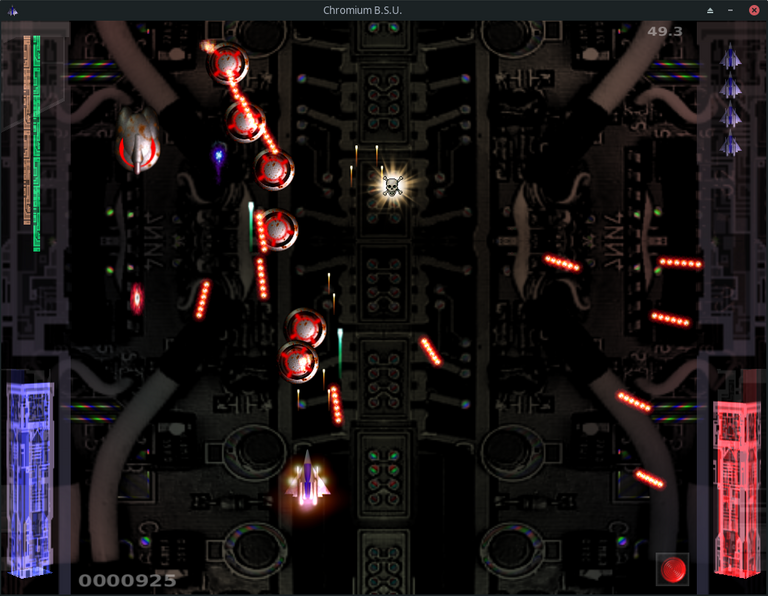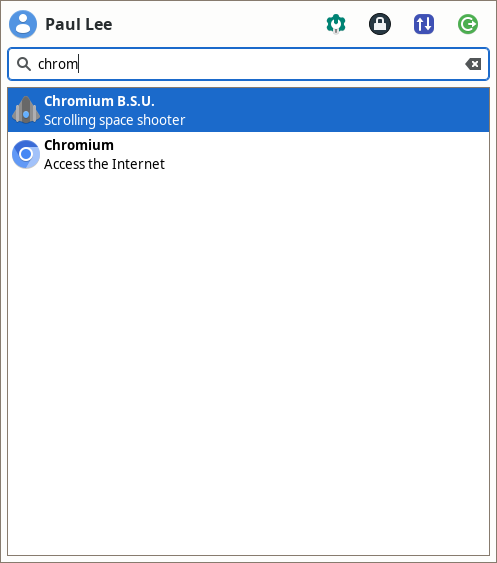The open source community always has delightfully creative alternatives to any kind of software you can think of, and that certainly includes games. Chromium BSU is the flagship open source videogame found in the mainstream Linux repositories for one genre subset: the vertical scrolling aerial/space shooter. This is the kind of game represented by Raptor: Call of the Shadows and Tyrian 2000 from the old publishers from the shareware age, Apogee and Epic MegaGames.
Chromium pulls off the core design of the vertical scrolling shooter excellently, though without a ton of variety. There are several different kinds of ships including the standard formations of enemy ships moving in various patterns, small ships that mob the player and don’t pass down off of the screen until they are destroyed, and tough mini-bosses that require may hits to take down and keep retreating back up into the top of the screen. The unusual feature that fundamentally alters the play style is that every enemy ship that passes down off of the bottom of the screen causes the player to lose a life. Frequently, players have to smash the player ship against escaping enemies, spending shields and health to prevent losing lives. There is a “super shield” power-up that effectively turns the player’s ship into a kind of melee weapon, as well as other power-ups, all falling from the top of the screen in the traditional way, for restoring ordinary shields. Other power-ups are weapons, providing broader cover fire, more damage, and penetration through enemies. The capacity for these weapon power ups is based on ammunition supply rather than by time, so it pays off not to be shooting when there’s nothing vertically above the player ship to hit.

This creates another part of the gameplay dynamic – a trade off between limited ammunition and the shield/health capacity, and both of those balanced against the limited number of lives. There are three ways to lose a life:
- when the player ship runs out of health
- when enemy ships make it past the player and advance down through the bottom of the screen
- and when the player clicks the right mouse button twice, which causes the player ship to self destruct
When the player ship self-destructs or is destroyed, a big blast clears the screen of all enemies, with the exception of the major end-of-level bosses. An advantage to self-destructing is that all the active power ups will be “ejected” by the ship for the next ship to retrieve. Like an Everquest player returning to his corpse after being killed to get his gear back, the player in Chromium BSU can get back all the weapons and shields from before self-destructing by flying back over the spot where the previous ship exploded. The ejection of the power-ups does not happen when the ship is destroyed from losing too much health; so it is advantageous to keep on eye on the health-and-shields meter on the lower left of the screen and to self-destruct instead of being killed when it gets very low.
Aesthetically, the graphics and animations feel like what we might expect from the Windows 95 era, about equivalent to the category of graphics seen in Raptor. The animated text on the title menu and the heavy use of faux 3D for interface elements have plenty of 90s energy. This is authentic and not retro, since the first version of Chromium BSU was created by one programmer in the year 2000. While all the animation effects might feel gratuitous and outmoded, the indicators in the interface are very usable and are critically important in gameplay. On the upper left, the remaining quantities of the different kinds of ammunition are depicted as vertical bars of different colors. The lower left and right show remaining shields and remaining health, respectively, using three-dimensional rotating bars made out of two colors in a sort of stylized circuitry pattern. When a super shield power-up is equipped, the blue bar on the left and the red bar on the right are both overlayed with an orange pattern representing the remaining energy supply of the super shield. This looks cool and is actually useful; watching the bars is an integral part of the experience of figuring the game out.
This visual fun is the most important part of the aesthetic, as there is no narrative to speak of. There is no frame story or explanation for the scenario anywhere within the actual game. The Sourceforge website contains a simple overview involving an off-screen freighter ship being defended by the drone fighters that the player controls. Without any “hanger” experience between missions where players can chill out and buy interesting upgrades for their ship, as found in both Raptor and Tyrian, Chromium BSU struggles to maintain enough interest to keep players cruising along, although its experimental mechanics and groovy graphics make the ride a fun one.
Most players are Linux users who found the game in their repo’s software manager. I’m guessing that many people initially find it when searching for the web browser named “Chromium” (the off-branded version of Google Chrome with the entirely blue version of Chrome’s colorful icon).

There’s plenty of hacker value in this game, which has different options for which libraries to use for various features when compiling from source. There is even a nifty extra feature buried in configuration files that can’t be selected from the regular menu in game – specifically, the option to play custom music instead of the generic synth beat. A super cute demonstration both of this game’s age and its experimental niche is that it can play music off of an audio CD inserted into your computer’s disc drive. It changes to the next track every time a level is cleared, or when “n” on the keyboard is pressed. This CD playback works on a second Windows port that I downloaded from ModDB.com.
The tradition of little freeware games made by hobbyist programmers or by open source teams is an old one, parallel to the shareware tradition and underlying some aspects of today’s indie game scene. A lot of these old programmer games have extremely creative and color mechanics but are excruciatingly difficult, while other indie games can be very easy. In all of that Chromium BSU strikes a good balance by being hard but playable.
Whether or not this delightful little game may be a bygone experiment, it doesn’t hurt to dust it off for some honest, free-flowing, vertical scrolling action. Particularly when you type “Chromium” into your software manager and inspiration strikes.